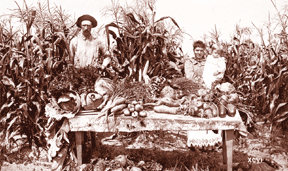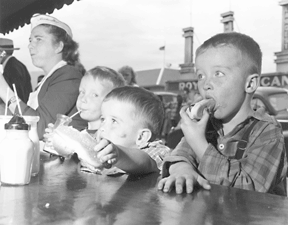Our Culture of Cuisine
How the Smithsonian Institution and Calvert Library found the Key Ingredients to America’s melting pot.
by Diana Beechener, Bay Weekly staff writer
From pot roast to paper-sack fries to pot stickers to pizza to pineapples, American appetites have commonalities that unite us across our quirks. From game, corn and beans, our cuisine has survived invasions and ocean crossings, expanding to reflect our diversity and narrowing with the homogenizing force of fast food. To illustrate America’s diverse and historic food connections, the Smithsonian Institution launched Key Ingredients: America by Food.
Maryland native Charles Camp, who lives in Catonsville, created the exhibit to show us the common ground and great diversity in American eating. Since 2002, the exhibit has brought common food practices and unique traditions to small communities around the country. This week, Key Ingredients arrives at the Calvert County Library in Prince Frederick, the fifth of six stops in Maryland. You’ve six weeks to drop in and ingest the history of Southern Maryland’s cuisine mixed with culinary traditions ranging from Native American to Betty Crocker.
Creating the Recipe
Tell me what you eat, and I will tell you what you are.
–Jean Anthelme Brillat-Savarin: The Physiology of Taste
“The exhibit is really about how an activity — eating, cooking — that we engage in multiple times a day can be seen as something that tells us where we’re from both in cultures and communities,” says Smithsonian national exhibit curator Charley Camp of his 800-square-foot homage to American eating.
Camp pitched the idea to the Smithsonian as a traveling exhibition on the history of food in America. The idea expanded into an edible version of the American experience, encompassing such aspects of food life as small-town food festivals, feasting holidays such as Thanksgiving and food processing.
As the Smithsonian menu shifted, so did its venue. Instead of museums around the country, the exhibit would be served in Museums on Main Street.
Prep Work
Food is our common ground, a universal experience.
–James Beard, author and culinary historian.
The treasures amassed by the Smithsonian Institution sprawl through 19 museums, with thousands of artifacts secured in basements, waiting for their chance on the display floors. To present its wealth of relics, the Smithsonian Institution Traveling Exhibition Services takes to the road with shows ranging from portraits of exotic birds in Panamanian jungles to artifacts from baseball legend Roberto Clemente’s collection.
Though Traveling Exhibition Services flies or trucks these pieces of American history from coast to coast, its showcases are limited. Security must be provided for each exhibit; often pieces must be stored in temperature- and light-controlled environments. So Smithsonian exhibits can’t reach many places in America.
The Smithsonian’s way into the heart of America is its Museum on Main Street program, partnering with every state’s humanities council to bring non-precious artifacts and exhibitions to rural museums.
“We wanted to get Smithsonian programs into small communities,” says Terri Cobb, registrar for Museum on Main Street. “We send five copies of each exhibit to five states, where it tours for a year.” Museum on Main Street leaves location choices to each state’s humanities council but sends tips to ensure success.
“We do training for each community, teaching them publicity, promotion and installation so that they know how to present the exhibition,” says Cobb. The point of the program is involving communities; every Museum on Main Street — which need not be a museum at all — must enrich the exhibit with its own ideas and artifacts.
“The heart of the program is each community contributing their own story to the national exhibit,” Cobb says.
Adding Ingredients
You don’t have to cook fancy or complicated masterpieces — just good food from fresh ingredients.
–Julia Child, chef, cookbook author and television teacher
Before boxing up a comprehensive exhibit on American food, Charley Camp had to plan the menu. Sifting through a smorgasbord of food-related culture, Camp searched for items to explain America’s foodways.
“The idea was not to provide a smooth narrative of food in American life but to suggest some of the touchstones, from growing it to gathering it to consuming it,” Camp says. The exhibit was roughly divided into five categories: agricultural foods, regional food identity, the role of technology in food processing and preservation, eating events and cooking at home.
Furnishing the exhibit was left to curator Camp, who searched EBay auctions and local rummage sales for objects of interest. Camp hunted far and wide, but he also found treasures in his own town. “A hardware store near me went out of business,” he says. “They had a lot of appliances from the 1930s that they had never sold.” Steadily compiling a collection of commercial memorabilia and appliances, Camp also spent time researching food festivals and etiquette traditions across the country. Mixing images of early farmers selling produce from roadside stands with the slick neon and bright colors of a 1950s diner, he drew the wide range of America’s appetite.
“Food is something everybody can identify with, no matter where you’re from,” says Cobb. The cultural significance of cooking became a focus for the exhibit, with a section dedicated to the ethnic origins of foods. The exhibit points to the foreign ancestry of most American foods, tracing popular dishes such as apple pie and pizza to their original countries: England, Germany and Italy. See the exhibit, and you learn to read the menus of most American restaurants as abridged immigration tales.
Breaking down the cultural significance of recipes led to the American Cookbook project, featured on the Key Ingredients website and in the Calvert exhibit. Here you share favorite family recipes, along with origin stories. Browsing the database by state, ethnicity or story-type, you can trace the roots of favorite foods and discover the diversity of American eating habits.
Geography, you learn, plays a key role in cooking and eating, as recipes alter from state to state.
Camp chose a 1930s motif for the exhibit and accompanying website. Pictures of smiling women in pearls and aprons serenely labeling preserves or setting a table greet visitors to www.keyingredients.org. Though the graphic design conjures up Norman Rockwell-like nostalgia, Camp insists that the images are part of a common cultural vocabulary.
“The style is a way of uniting people,” Camp says. “We recycle advertising ideas, the younger generation recognizes the images as part of a vocabulary of symbols that are still in play, and the older generation remembers them.” The mostly Caucasian images create an ironic counterpoint to the exhibit’s hypothesis that American food consumption is our nation’s greatest experience of diversity.

Altering the Recipe
Even at her most solitary, a cook in the kitchen is surrounded by generations of cooks past, the advice and menus of cooks present, the wisdom of cookbook writers.
–Laurie Colwin, American food writer and novelist
Packed into 19 wheeled crates each weighing no more than 200 pounds, Key Ingredients sits in the back of a Prince Frederick-bound U-Haul truck. The second-to-last stop on the exhibit’s Maryland Tour, Key Ingredients sets up at the Calvert Library in Prince Frederick starting January 11. Running until February 23, the exhibit showcases the range and rich history of Southern Maryland’s cooking traditions and the agrarian pride of the county.
“Calvert County is the perfect place for a food exhibit,” says the library’s Robyn Truslow. “Our history is agriculture and watermen.”
The six-week exhibition is also, Truslow says, a much-deserved bit of recognition for the county and its library: “Calvert County is worthy of a Smithsonian-level exhibit. It will draw people all through Southern Maryland.”
Walking through the exhibit, you’ll tour the American eating experience. Beginning with agriculture, you learn how land has changed from early Native American cultivating techniques to the air-conditioned, computer-equipped tractors that till modern fields. You discover the role of technology in foods, learning how refrigeration and chemical preservatives changed the way we consume meals. The quirks and curiosities of American foods appear in a pictorial featuring food festivals and theme dining.
The highlight of the exhibit is the library’s look into Southern Maryland’s rich culinary past and present. You explore the farming traditions of Southern Maryland, look at the traditional crops and learn about locally grown produce. Calvert County — which is trying to recreate a farmers’ market after closing its grand five-year experiment last year — celebrates local crops with pictorials of the markets and stories about roadside sellers.
Local church groups open up their cookbooks, giving visitors insight into community dinners and homemade meals. “I think every church here does about six dinners a year,” Truslow says. “Food’s important to us in Southern Maryland.”
Bring pen and paper or your Black Berry to copy favorite recipes or to submit your own recipe to the library’s contest.
Calvert Marine Museum sponsors a special addition to Key Ingredients, dedicated to the Seafood Industry in Southern Maryland and chronicling the lives of watermen through photographs and equipment displays. Maryland fishing and cooking writer Lenny Rudow docks at the exhibit January 24 to teach you how to catch and prepare the perfect fish dinner.
“This is a touchable exhibit where people can pick things up and try to figure out what they do,” says Truslow. Roll up your sleeves at the odd utensils section, where the Calvert Historical Society tries to stump you with weird and wacky appliances and kitchen tools.
In honor of Key Ingredients, all Calvert Library branches consume food-themed book discussions, film screenings and lectures. All the county’s libraries also invite younger guests to design a placemat for a special addition to the Prince Frederick program.
Plate and Serve
There is no love sincerer than the love of food.
–George Bernard Shaw: Man and Superman
Between Southern Maryland stuffed ham and pad Thai noodles lies a world of culinary options for hungry Americans. Key Ingredients offers you the recipe for the American melting pot, outlining the different foods and similar traditions. Though we may use different spices, we share the experience of eating with the world.
“Cooking and eating are mundane activities, but within that world many of these ordinary objects and activities tell us about ourselves,” Camp says. “Food allows us to articulate our views of family, ethnicity and community.”
As you thumb through church cookbooks and study Native American dining rituals, Camp’s connection between community and food gets clearer: Eating brings everyone to the table.
“I hope that it will help people be thoughtful about food’s role in daily life, not just feeding yourself, but your spirit,” says Truslow.
Over decades, we Americans have incorporated all ethnicities into our food traditions, replacing rigid ethnic heritage with a broad, inclusive culinary culture. Key Ingredients proves that any dish you eat is as American as apple pie.
Let us know what you think
Join the Bay Weekly Forum
|
|
|
|